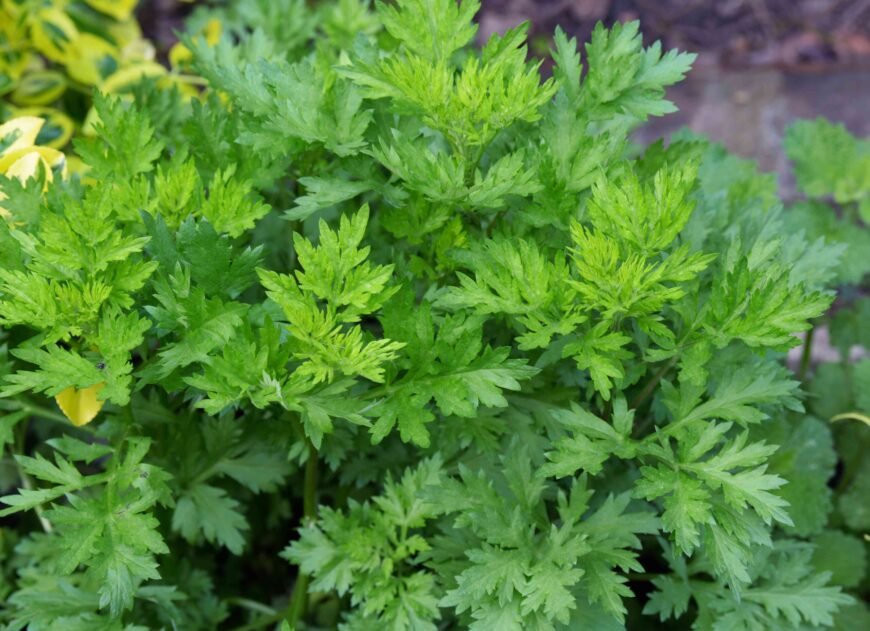Like other invasives that home gardeners struggle to remove from their landscapes today, mugwort (Artemisia vulgaris) was introduced to North America in colonial times with a purpose. This perennial aromatic herb was historically grown for medicinal purposes and it is used as a herbal supplement to the present day.
Mugwort forms dense mats and chokes out all other plants, leading to large stands of mugwort monocultures. Removing mugwort is challenging and takes persistence because as long as any of the rhizomatous roots remain, this highly invasive plant will grow back with a vengeance. Here’s how to effectively prevent mugwort from taking over your garden beds or lawn.
| Common Name | Mugwort |
| Botanical Name | Artemisia vulgaris |
| Plant Type | Perennial, herbaceous |
| Mature Size | 2-5 ft. tall, 3-6 ft. wide |
| Soil Type | Well-drained |
| Bloom Time | Summer, fall |
| Flower Color | Yellow, green, purple |
| Hardiness Zones | 3-8 (USDA) |
| Native Area | Europe, Asia |
Mugwort Invasiveness
Warning
Mugwort is found across North America and is the most widespread in the eastern United States and Canada. It is considered an invasive species in many states, including Maine, New York, New Jersey, Pennsylvania, Indiana, Kentucky, and Georgia.
Mugwort grows in a wide range of temperatures and soil conditions, including poor, dry, moist, or highly alkaline soil. It spreads vigorously by rhizomes and establishes itself virtually in any sunny habitat where it forms thick, dense mats and crowds out native species. Its invasive nature is aggravated by its allelopathic properties. Mugwort releases chemicals into the soil that deter other plant species from growing.
What Does Mugwort Look Like?
Mugwort is a branched perennial that grows to a height of 2 to 5 feet. The angular stems are purplish-brown and hairless except for the flowering stems. The branching root system of mugwort is extensive.
The dark green lobed leaves are alternate and resemble those of mums but the undersides of the leaves have white hairs. Depending on the age of the plant and where the leaves are located on the plant, the leaves are shaped and lobed differently and may be serrated. When crushed, the leaves emit a spicy scent.
The flowers in late summer to early fall are tiny and inconspicuous and grow in clusters at the top of the plant. The flowers start as whitish-green and change to purplish as they age.
How to Get Rid of Mugwort
What makes mugwort removal so challenging is that the plant regrows from root segments smaller than one inch. Hand pulling only works if you have just a few very young plants that have not yet developed an extensive root system. Getting rid of any mugwort patch requires the use of herbicide.
Especially if the infestation is large, start by trimming or mowing the plants at least once starting in early summer and again a few weeks later depending on how fast the mugwort regrows. In late summer or early fall, spray the plants with a non-selective herbicide such as glyphosate, or a selective herbicide, such as triclopyr and clopyralid. The herbicide is unlikely to eradicate all the plants permanently so you will have to monitor the area in the following year and retreat it as needed.
How to Prevent Mugwort From Spreading
Preventing mugwort from spreading requires the same steps as fully eradicating the plant because mugwort primarily spreads via rhizomes. As long as there are rhizomes left in the ground, it will continue to spread.
Harvesting Mugwort
The only benefit of having mugwort growing in your yard is that the roots, leaves, stems, and flowers of mugwort are usable for herbal remedies. The best time to harvest the leaves is just before the tiny flower buds open. Cut off the stalks and hang them upside down in a warm place indoors to dry, then strip off the leaves.
If you miss that moment, you’ll get another chance in the fall before the first frost. Cut off the top third of the plant and hang it up to dry.
-
-
Mugwort is used as an herbal remedy to treat several health problems.
-
-
-
The compounds in mugwort can be toxic.
-
-
-
In some states, including Indiana and New York, mugwort is prohibited from being sold, transported, distributed, or propagated because of the invasive nature of mugwort.
-
